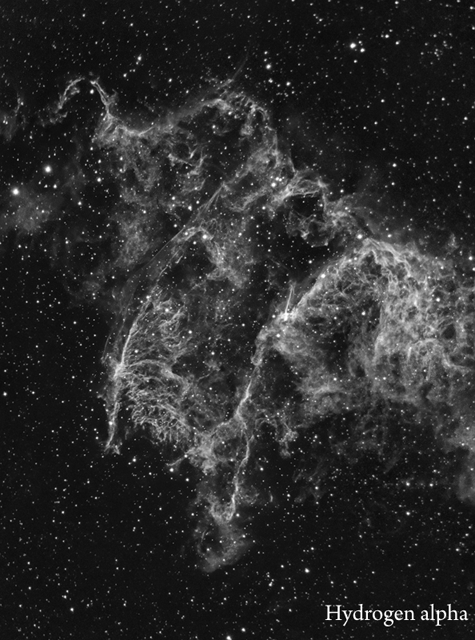COPYRIGHT, PLEASE NOTE
All the material on this website is copyrighted to J-P Metsavainio, if not otherwise stated. Any content on this website may not be reproduced without the author’s permission.
BUY A MUSEUM QUALITY POSTER
BUY A POSTER:https://astroanarchy.zenfolio.com/
Tuesday, September 25, 2012
IC 1340 project as a bi-color from hydrogen and oxygen
IC 1340, Part of the Eastern Veil Nebula in Cygnus
RA: 20h56m 45.8s DE:+31 degrees07' 17"
Colors are mixed R=H-a, G=O-III and B=O-III + 5%H-a
An experimental starless version to show the actual nebula better
An animation to show difference between H-alpha and O-III emissions
Hydrogen and the Oxygen are clearly separated
Orientation image
Area of interest is marked as a white rectangle in this older wide field image above.
Technical details:
Processing work flow:
Image acquisition, MaxiDL v5.07.
Stacked and calibrated in CCDStack2.
Levels, curves and color combine in PS CS3.
Optics, Meade LX200 GPS 12" @ f5
Camera, QHY9
Guiding, SXV-AO, an active optics unit, and Lodestar guide camera
Image Scale, ~0,8 arc-seconds/pixel
16 x 1200s exposures for H-alpha emission = 5h 20min.
12 x 1200s exposures for O-III, emission of ionized oxygen = 4h
IC 1340 in Eastern Veil Nebula. Image shows a starless version of pure ionized Oxygen, exp. time ~5h.
This is a second version of this photograph. It looks like an electric version of the Nike statue!
Ps.
I made an animation about different components in my image.
In this animation, allthe components in my image of IC 1340 are separated.
Looks odd but it's very useful while processing the image, since operations can be done to single element in image without interfering other image components.
NOTE. There is absolutely zero data lost in this technique due to my processing method.
I'm using a "difference mapping" between images and all the removed components gets placed back byte by byte in final image!
Monday, September 24, 2012
First project, IC 1340, of Autumn 2012 continues
The weather hasn't been on my side. At four nights, I have managed to collect about three two hours set of Hydrogen alpha light exposures. Now there is more details and less noise, than in previous two hours version.
I'll shoot other channels, ionized Oxygen and Sulfur, for the color image, as soon as the weather cooperates again.
IC 1340, Part of the Eastern Veil Nebula in Cygnus
RA: 20h56m 45.8s DE:+31 degrees07' 17"
Detail of Eastern part of the Veil Nebula in H-a light only.
A closeup
IC 1340 is part of the Veil Nebula, a supernova remnant in constellation Cygnus at distance of about 1470 light years. This is one of the more luminous areas in this SNR. Image is B&W, since it shows only a light emitted by ionized Hydrogen. The shock front formed by the material ejected from giant explosion, the super nova, can be seen in this image.
There is only two hours of exposures integrated in this image. I'll need least three more hours for H-alpha and about a same amount for O-III and S-II to make a color composition out of this target.
There is only two hours of exposures integrated in this image. I'll need least three more hours for H-alpha and about a same amount for O-III and S-II to make a color composition out of this target.
Orientation image
Area of interest is marked as a white rectangle in this older wide field image above.
Technical details:
Processing work flow:
Image acquisition, MaxiDL v5.07.
Stacked and calibrated in CCDStack2.
Levels and curves in PS CS3.
Optics, Meade LX200 GPS 12" @ f5
Camera, QHY9
Guiding, SXV-AO, an active optics unit, and Lodestar guide camera
Image Scale, ~0,8 arc-seconds/pixel
16 x 1200s exposures for H-alpha emission = 5h 20min.
Sunday, September 23, 2012
My equipment
I'm shooting my astronomical images from downtown Oulu. This is my collection of gears needed for my astroimaging. Canon EF 200mm camera lens can't be seen in images here.
This is a new combination from old gears. Now I'm able to shoot with two cameras at ones! QHY9 is used for longer focal length work with my old Meade LX200 GPS 12" telescope at about f5. QHY8, a cooled single shot color imager, is used with Tokina AT- X 300mm camera lens for wide field work.
Now I can have both, a closeup and a wide filed images, from same target at same time. I'll test, if color information from QHY8 camera can be used with images taken by QHY9 camera.
As you can see, I don't have any fancy gears for my work.
Not a pretty boy...
Lots of cords. They might look unorganized but I can sure you, there is a system.
Light path from the telescope to camera. There is an active optics unit at middle. (SXV-AO)
Counterweight, Meade fork mount and the dew heater control box at right.
The other side of the scope.
The ugly yellow fabric, at top, works as an insulation for the
heater stripe at front of the QHY8 camera. It's heated due the frost.
Images taken with Meade LX200 GPS 12" telescope

Labels:
equipments
Friday, September 21, 2012
New exhibition of my astronomical images
Sorry, in Finnish only this time, since the exhibition happens in Liminka, Finland.
Näyttely Limingan Taidekoulun tiloissa 21.09 - 16.10. 2012
"DIMENSIOITA"
Kuvia taiteen pimeältä puolelta
J-P Metsävainion tähtikuvia
An exhibition poster
Labels:
publications
Subscribe to:
Comments (Atom)























